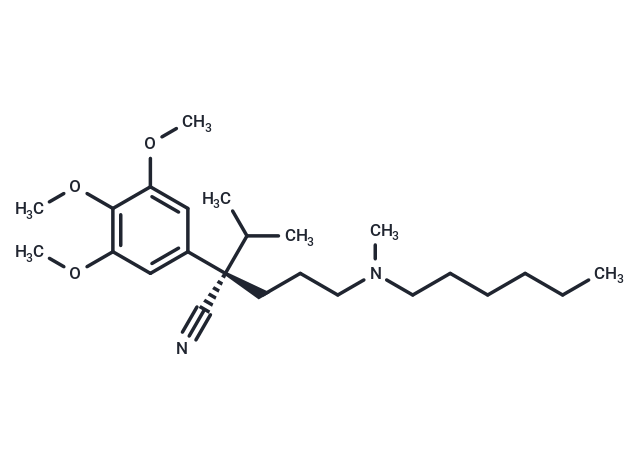Shopping Cart
- Remove All
 Your shopping cart is currently empty
Your shopping cart is currently empty

Nexopamil (LU-49938) is a calcium channel antagonist and a 5-hydroxytryptamine 2A receptor antagonist. Nexopamil inhibits 5-HT-induced contraction and proliferation of mesenchymal cells.

| Pack Size | Price | Availability | Quantity |
|---|---|---|---|
| 1 mg | $72 | In Stock | |
| 5 mg | $173 | In Stock | |
| 10 mg | $263 | In Stock | |
| 25 mg | $437 | In Stock | |
| 50 mg | $646 | In Stock | |
| 100 mg | $919 | In Stock | |
| 200 mg | $1,250 | In Stock |
| Description | Nexopamil (LU-49938) is a calcium channel antagonist and a 5-hydroxytryptamine 2A receptor antagonist. Nexopamil inhibits 5-HT-induced contraction and proliferation of mesenchymal cells. |
| In vitro | Nexopamil abolished in a concentration-dependent way the serotonin-induced [3H]thymidine incorporation into DNA, and the serotonin-induced increase in a number of cells. Nexopamil partially blocked the serotonin-induced mesangial cell contraction, in a dose-dependent manner blocking 5-HT2 receptors and the voltage-operated Ca2+ channels.[3] |
| Alias | LU-49938, LU49938, LU 49938 |
| Molecular Weight | 404.59 |
| Formula | C24H40N2O3 |
| Cas No. | 136033-49-3 |
| Smiles | [C@@](CCCN(CCCCCC)C)(C(C)C)(C#N)C1=CC(OC)=C(OC)C(OC)=C1 |
| Relative Density. | 1.31g/cm3 |
| Storage | Powder: -20°C for 3 years | In solvent: -80°C for 1 year | Shipping with blue ice. | |||||||||||||||||||||||||||||||||||
| Solubility Information | DMSO: 55 mg/mL (135.94 mM), Sonication is recommended. | |||||||||||||||||||||||||||||||||||
Solution Preparation Table | ||||||||||||||||||||||||||||||||||||
DMSO
| ||||||||||||||||||||||||||||||||||||

Copyright © 2015-2025 TargetMol Chemicals Inc. All Rights Reserved.